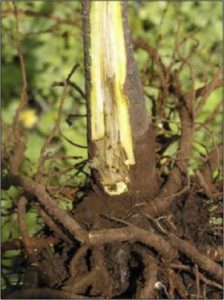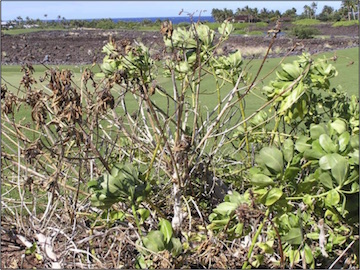Pest of the Month — Verticillium Wilt
DESCRIPTION
Verticillium wilt is caused by a variety of fungal species of the genus Verticillium, most notably V. dahliae and V. albo-atrum. It is “one of the most widespread and destructive soilborne diseases of plants” (UC IPM). Verticillium infects a plant through the roots and multiplies in the xylem, plugging the water-conducting tissues. The fungi’s resting structures (microsclerotia) can survive in soil for many years.
“This wilting beach naupaka (Scaevola sericea) plant was growing in a thin layer of soil covering a field of lava at a golf course… In this case, the soil contained Verticillium dahliae. This fungus does not commonly occur in Hawai‘i’s beach sands, so it does not normally cause naupaka to contract the disease in its native, coral beach sand habitat.” (Landscape Disease Problems in Hawai‘i, Pub. PD-67 — Feb. 2009). Photo by Scot C. Nelson, UH-CTAHR.
DISTRIBUTION
Globally widespread throughout temperate, tropical and subtropical regions. It may be more common in poorly drained clay soils.
HOSTS
Verticillium wilt infects some 400 plant species including herbaceous annuals such as tomato, perennials such as pineapple, and woody species. APSnet.org provides a list of some of the most common hosts (along with species that are resistant or immune). CTAHR’s “Checklist of Plant Diseases in Hawaii” has fourteen listings of disease conditions in different hosts, including: Ananas (pineapple), Codiaeum (croton), Eucalyptus, Hibiscus, Metrosideros, Musa (banana), Scaevola (naupaka), Solanum (herbaceous).
SYMPTOMS AND DAMAGE
Symptoms are variable depending on the host species, but generally include:
• Flagging and yellowing of leaves on one branch or one side of the tree, or the whole tree if it is small. Symptoms of wilting are most obvious on warm, sunny days. Leaves turn tan or brown before dying, and sometimes remaining attached.
• Water-conducting tissues including roots and sapwood are often discolored olive green, brown or black. Some plants, such as olive, ash and rose, do not display vascular discoloration.
• Field diagnosis should be confirmed by lab analysis.
CONTROL
• Specify plants that are selected or bred for resistance. Avoid susceptible species.
• Inspect plants from the nursery carefully for symptoms that could indicate wilt disease.
• Steam, solarization, and chemicals are available for treating growing media. (see UC IPM)
• Remove and destroy plants exhibiting symptoms, and prune to remove dead branches.
• Where supplemental irrigation is applied, allow soil to dry between watering cycles.
• Provide ample drainage.
ADDITIONAL RESOURCES
Berlanger, I. and M.L. Powelson (2000). “Verticillium wilt,” The Plant Health Instructor (DOI: 10.1094/PHI-I-2000-0801-01), Updated 2005. URL: http://www.apsnet.org/edcenter/intropp/lessons/fungi/ascomycetes/Pages/VerticilliumWilt.aspx
“How to Manage Pests, UC Pest Management Guideline: Verticillium Wilt (Reviewed 3/09, updated 3/09),” University of California Agriculture and Natural Resources, Statewide Integrated Pest Management Program. URL: http://ipm.ucanr.edu/PMG/GARDEN/PLANTS/DISEASES/vertwilt.html
Raabe, Robert D., Ibra L. Conners and others; revised by Scot C. Nelson (2009). Checklist of Plant Diseases in Hawaii [ITS-022]. URL: http://www.ctahr.hawaii.edu/site/PubList.aspx?key=Plant%20Disease

